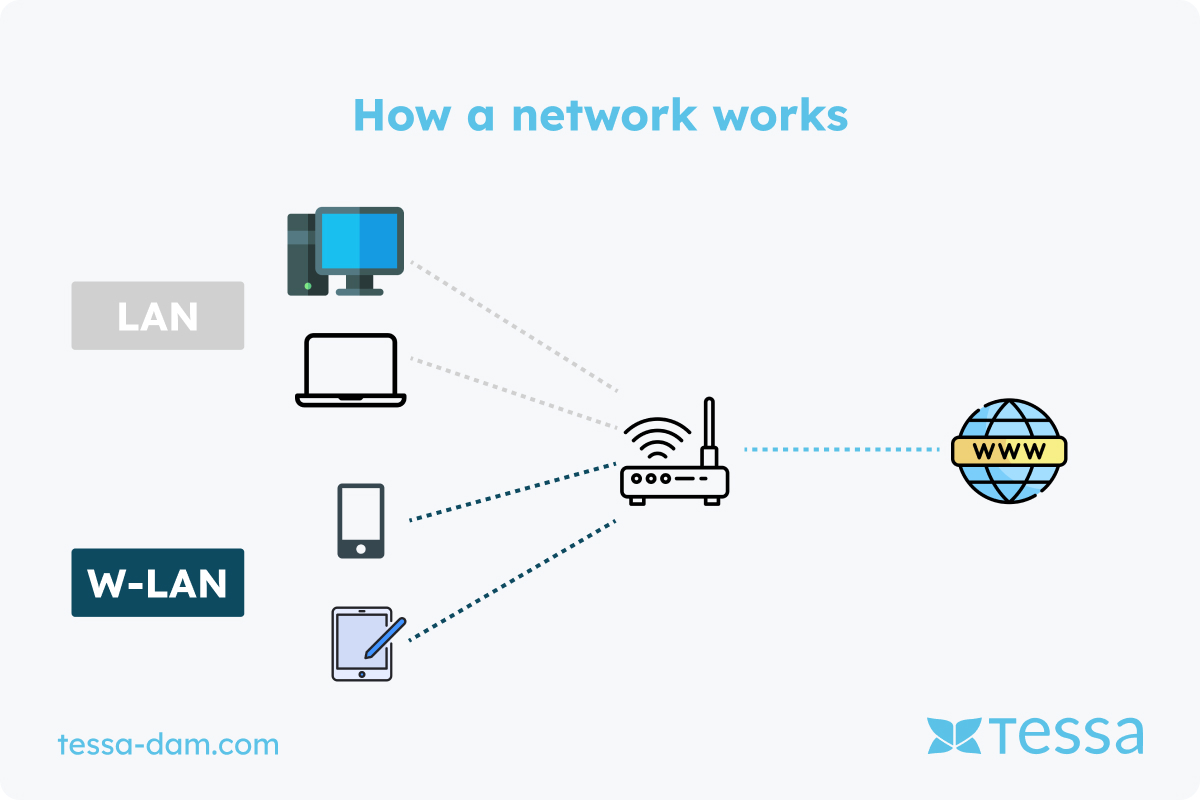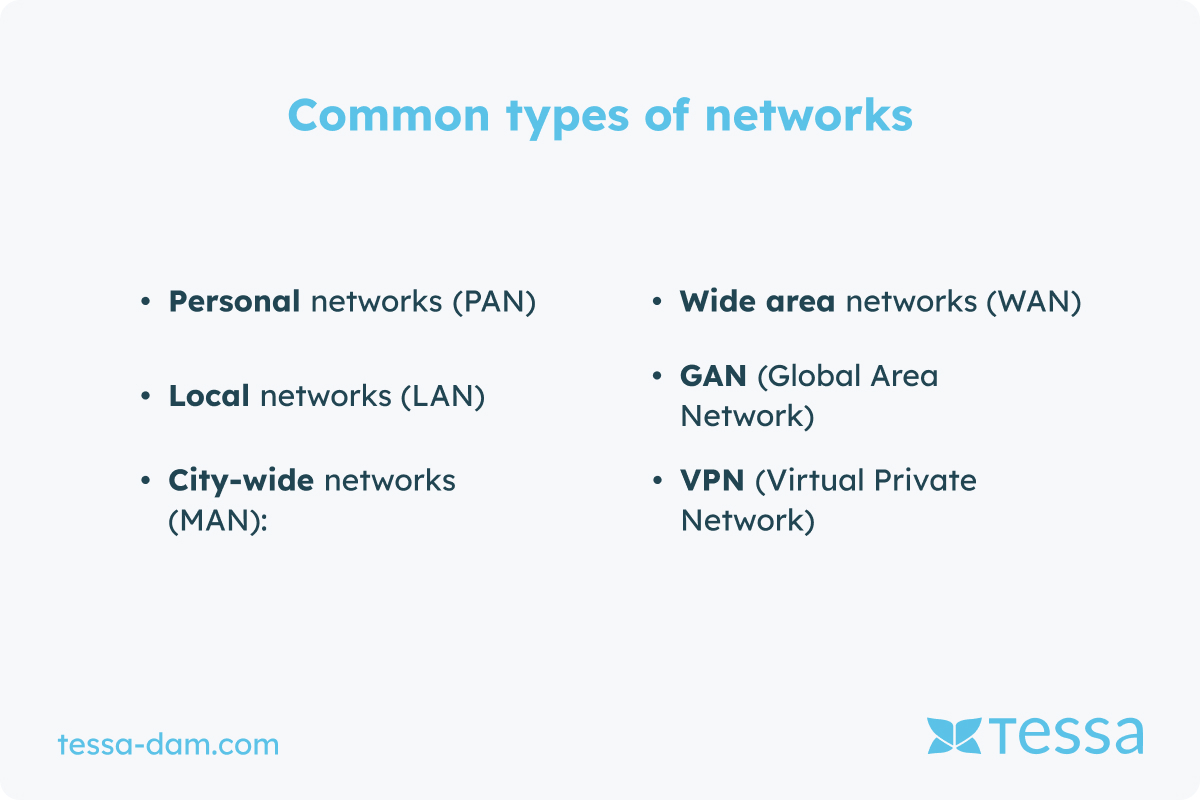Introduction
In today's world, networks play a central role in communication and data transmission, making them an indispensable part of digital infrastructure. A network, in technological terms, is a group of two or more computers or other electronic devices connected to share resources, exchange data, and enable communication services. These connections can be either wired or wireless, enabling a variety of applications ranging from simple data exchange to complex cloud computing processes.
Wireless vs. wired networks
Wired networks
Wired networks use physical cables to transmit data between connected devices. This type of network provides a stable and reliable connection, as it is less susceptible to interference. The most common types of wired networks include Ethernet networks, which are based on Ethernet protocols and are commonly used in office environments and data centers. They offer high transmission speeds and low latency, making them ideal for high data traffic applications.
Wireless networks
In contrast, wireless networks use wireless technologies such as Wi-Fi (Wireless Local Area Network) or Bluetooth to connect devices and facilitate data exchange. These networks offer greater flexibility and mobility as users are not bound by physical connection cables. They are particularly prevalent in environments where rapid deployment and flexibility are required, such as in businesses, public facilities, and private households.
How does a network work?
A network operates by connecting multiple devices through physical cabling or wireless technologies such as Wi-Fi or Bluetooth. These devices can be computers, servers, printers, smartphones, IoT devices, and others. Communication between devices occurs through data packets exchanged between them. To facilitate this, network protocols such as TCP/IP (Transmission Control Protocol/Internet Protocol) are used, which define rules and standards for data transmission.
In wired networks, data is transmitted over Ethernet cables, with switches or routers used to control and distribute data traffic. In wireless networks like Wi-Fi, data is exchanged between devices via radio waves, with routers or access points providing connection points.
IP addresses are used for device identification and routing decisions. Data is sent in the form of packets containing information about the sender, receiver, and content. These packets are routed through the network to their destination, with switches, routers, and other network devices determining the path.
Common types of networks
Networks can be classified into various types based on their range, function, and the protocol used. The most well-known network types are:
Personal Area Networks (PAN): Short-range networks, usually for individual users, such as Bluetooth connections between smartphones and smartwatches.
Local Area Networks (LAN): Limited to a building or campus, such as the network in an office or university.
Metropolitan Area Networks (MAN): Cover a larger geographic area, often a city.
Wide Area Networks (WAN): Regional networks enabling national or international connections, such as the Internet.
Global Area Network (GAN): A network operating across multiple geographic locations, connecting various WANs.
Virtual Private Network (VPN): A private network established over a public network like the Internet, allowing users to securely access resources.
Network protocols and architecture
The functionality of networks is enabled by special software protocols that define how data is transmitted between devices. The most well-known set of network protocols is the Internet Protocol (IP), which, combined with the Transmission Control Protocol (TCP), forms the basis for data transmission on the Internet. Networks use a variety of devices to perform their tasks, including routers, switches, hubs, and firewalls. These devices help control traffic, ensure network security, and maintain the integrity of transmitted data.
Importance of networks
Networks are crucial for a range of modern technologies and business applications. They not only facilitate everyday communication via email or social media but are also critical for the functionality of e-commerce, online education, and remote work. In industry, networks enable the implementation of complex automation systems and the Internet of Things (IoT), connecting machines and devices in smart factories and homes.
What are the benefits of a network?
Networks offer a variety of benefits, including:
Resource Sharing: Networks enable the sharing of resources such as printers, scanners, files, and applications, increasing efficiency and reducing costs.
Data Exchange: Networks facilitate fast and easy exchange of data and information between different devices and users, regardless of their location.
Centralized Management: A network allows for centralized management of devices, users, and resources, making maintenance and updates easier.
Scalability: Networks can be easily expanded to meet new requirements and growth by adding new devices or improving network infrastructure.
Flexibility and Mobility: Wireless networks allow users to seamlessly connect from different locations, providing flexibility and mobility in the work environment.
Security: Networks provide various security mechanisms such as firewalls, encryption, and access controls to ensure the integrity and confidentiality of data.
Challenges and future outlook
Despite their many advantages, networks face numerous challenges, particularly in terms of security and privacy. Cyberattacks, such as data breaches and DDoS attacks, pose a constant threat. Additionally, the increasing volume of data transmission and the need to achieve higher speeds require continuous innovation in network technologies.
Future developments in network technology promise higher speeds, improved security, and greater integration of artificial intelligence for network management. Technologies like 5G and beyond will not only enhance mobile communication but also enable new use cases for remote and automated systems.
Wi-Fi in the household as a network example
A common example of a network in the household is a Wi-Fi (Wireless Local Area Network). In a typical scenario, various devices such as computers, smartphones, tablets, smart TVs, and IoT devices are connected wirelessly through a router. The router serves as a central access point, allowing devices to communicate with each other and access the Internet. Wi-Fi in the household enables residents to share files and media, access the Internet collectively, use wireless printers and other peripherals, and control smart home devices. This connectivity enhances household efficiency and provides convenience through the wireless connection of various devices and services.
Conclusion
An essential part of our digital society
In conclusion, networks are an essential part of our digital society, and their continuous development is crucial for maintaining and improving our technological and social infrastructures.






